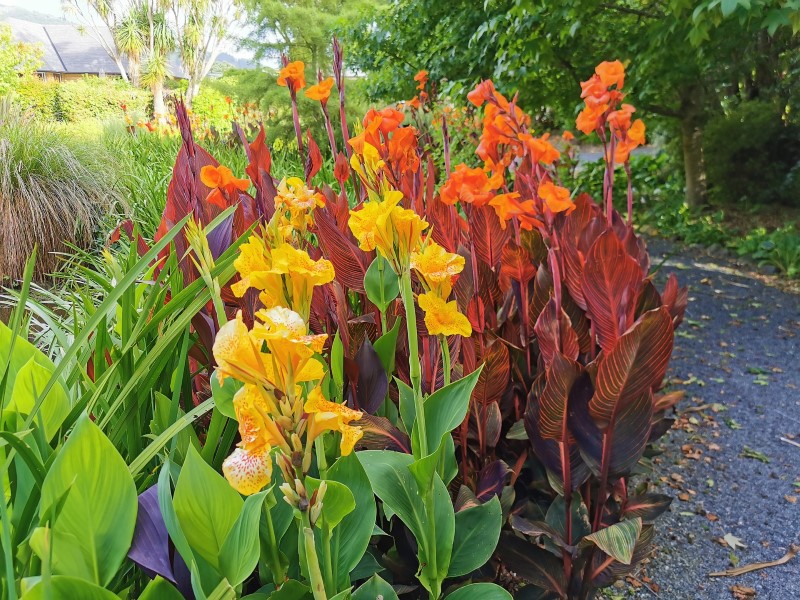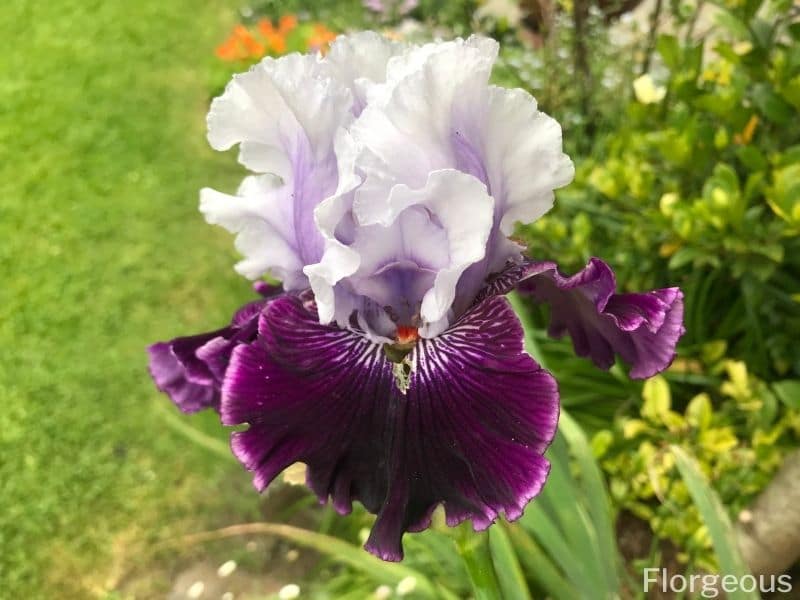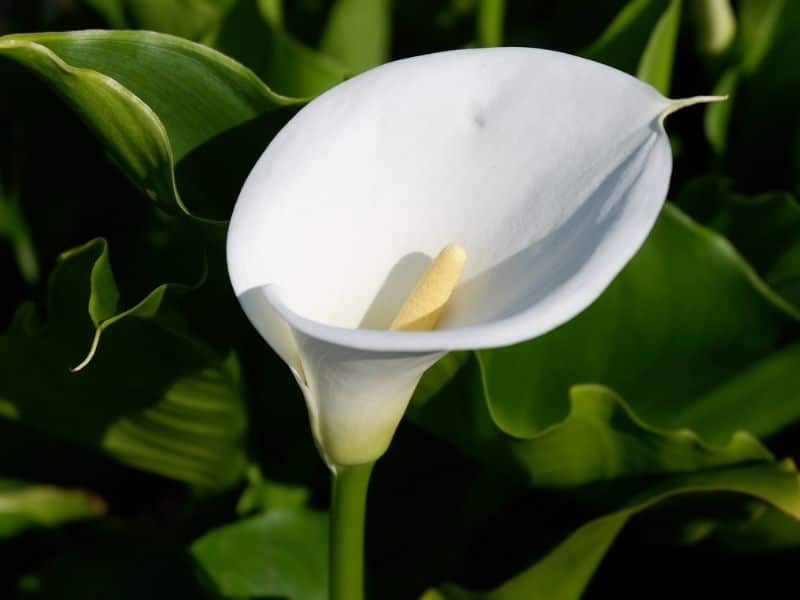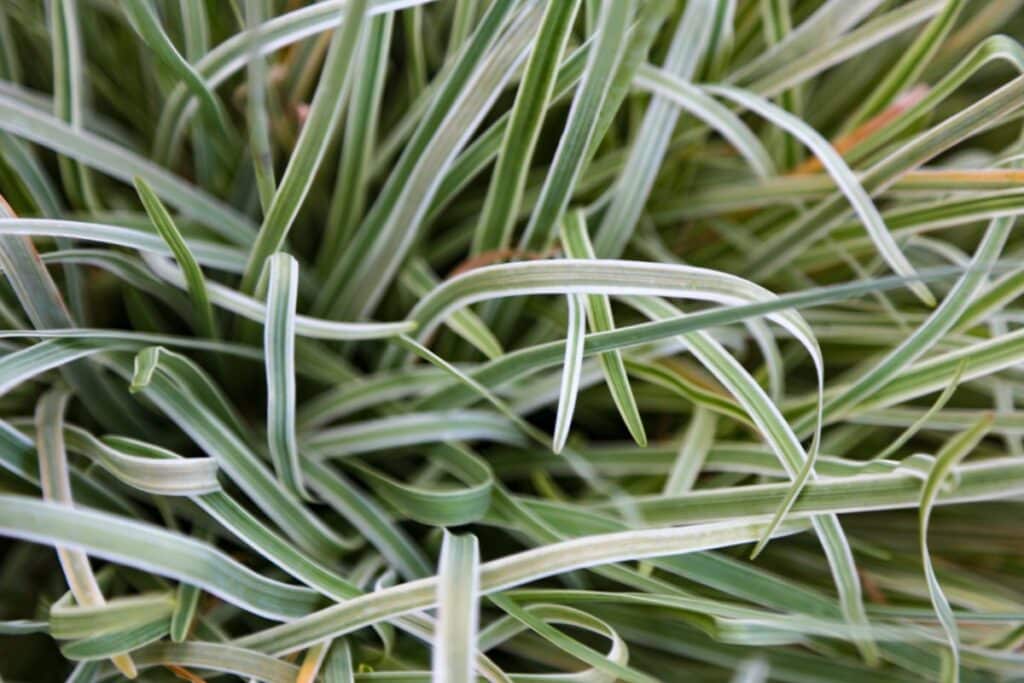Ribbon grass (Phalaris arundinacea), reed canary grass or gardener’s-garters is a very beautiful evergreen ornamental grass species that gardeners love to use in landscaping projects.
This grass variety can add lots of charm to your garden with its tall leaf blades and it is very easy to grow since it will quickly spread all over your garden spaces.
The grass is very flexible and can be used in containers, around ponds, or water masses, or it can be used to create showy borders or hedges around your garden bed.
You can combine ribbon grass with companion plants like cannas, irises, leopard plants, creeping jenny, or calla lilies to add more color to your garden. These plant species will complement ribbon grass and can add lots of interest.
In this guide, we are going to take a closer look at these companions and we discuss creative ways to use them in your garden.
What to Grow with Ribbon Grass
Ribbon grass grows optimally in containers, in woodland gardens, or around ponds. This plant species should be placed in partial shade because it can become scorched by direct sun, especially in warmer regions.
These decorative ornamental grasses can tolerate any soil type including clay soil as long as it drains well. It grows best in moist soil but can also withstand waterlogged conditions or slightly dry conditions.
If you want to keep these beautiful grasses healthy and vibrant then you should pair them with other plants that also enjoy lightly shaded positions with lots of moisture and rich soil.
Here is a quick look at some of the best companion plants for ribbon grass.
Cannas

Tall Cannas (Canna) with vivid yellow, orange, or red flowers will look rather striking alongside the shorter light tinted leaves of ribbon grass.
The cannas will add lots of height to your gardens while ribbon grass will act as a ground cover and fill out or lighten your garden while adding lots of texture with its tall leaf blades.
These tall flowers will flourish if they are grown in moist conditions and they take very well to any type of well-drained soil. Cannas are also light shade tolerant and can even grow well in bog-like conditions.
These two plants are ideal species to grow around ponds but they will also take well to containers.
Irises

Iris flowers (Iris) are also excellent ribbon grass companions because they will add lots of color to your garden when they produce showy flowers in colors like blue, purple, yellow, white, pink, orange, brown, or black. The long leaf blades of these perennials will also blend well with ribbon grass leaves.
Irises will bloom best if they receive lots of direct sun but they can tolerate a little bit of shade. Many varieties of irises will grow well in moist or even wet conditions but there are some that prefer dryer soil conditions.
When you are pairing irises and ribbon grass, you should be careful to position moisture-loving iris species like Siberian iris (Iris sibirica) or japanese iris (Iris ensata) in the wetter parts of your garden and species like the bearded iris in dryer parts of your garden.
You can also grow true water irises inside shallow waters or on the bank of ponds with ribbon grass close to it.
Leopard Plants
Leopard plants (Ligularia) are often grown for their beautiful foliage and heart-shaped leaves but they can also add lots of color to your garden when they produce long-stalked flowers in bright yellow colors.
These perennials prefer moist soil and can be planted in sun-to-shade positions. In a light shade position, they should bloom quite vigorously.
Leopard plants can look rather striking if you use them and ribbon grass to create showy borders. The light-tinted leaves of ribbon grass will add lots of color to your garden while the darker tones of ligularia foliage will create lots of contrast.
Golden Creeping Jenny
Creeping jenny (Lysimachia nummularia) or moneywort is an ideal companion plant to include in ribbon grass containers. The vivid lime-green foliage of this creeping plant will create a spiller effect if it trails over the edge of your containers.
Moneywort can grow well in any soil type but it should be kept moist. This ground cover plant also prefers shaded positions.
You can use creeping jenny as a ground cover in front of ribbon grass or grow it alongside ribbon grass on the edge of a pond. Creeping jennies love water and can be grown in water that is up to one inch deep.
Calla Lily

Calla lilies (Zantedeschia) are an ideal companion species to add to your garden if you want to add lots of color to your garden. This deciduous perennial comes in a wide range of colors including white, pink, yellow, orange, lavender, and dark maroon.
Calla lilies can grow well in full sun or partial shade and they should be watered once a week or more in warmer climates.
You can grow these beautiful flowering species in containers or garden beds with showy ribbon grass all around them. The ribbon grass will keep your garden bed nice and full when the calla lilies die down for the winter.
What NOT to Grow with Ribbon Grass
Ribbon grass prefers light shade positions but can withstand all sorts of moisture levels from relatively dry to wet. Because of its flexible nature, it can be grown alongside a huge variety of companions.
Gardeners should avoid pairing this grassy plant with sun-dependent plant species like coneflowers, blanket flowers, or lavender because ribbon grass can become scorched in the direct sun.
It is also best to avoid planting it with drought-tolerant species like succulents because ribbon grass is a bit thirstier and won’t survive in dry soil.
Landscaping Ideas for Ribbon Grass and Companions
Ribbon grass has many garden applications because it grows well in a variety of conditions. Here is a quick look at some of the most popular ways these ornamental species are often used to create showy spaces.
Container Gardens
Ribbon grass and most of the plants we discussed in this guide can grow well in containers.
You can grow them individually in bright containers and place them together for an interesting effect or mix and match taller and shorter species like cannas and ribbon grass in the same container.
Add a little bit of creeping jenny as a spiller plant to your garden pot and you will have a perfect mixed container.
Around Ponds Or Water Features
Ribbon grass can tolerate lots of moisture. You can use this grass along with other moisture-loving species like irises or cannas and plant them around fish ponds or other types of water masses.
Gardeners also enjoy growing creeping jennies close to the water bank with true waster irises inside the shallow waters to create a whimsical effect.
Showy Hedges
Ribbon grass can be paired with species like the calla lilies, irises, or leopard plants to create showy mixed borders. These borders can look striking if you grow them around garden beds or alongside walkways or driveways.
Final Thoughts
Ribbon grass is an ideal species to include in your landscape if you want to create a low-maintenance garden. This showy ornamental grass can be combined with companion plants like irises, cannas, calla lilies, creeping jenny, or leopard plants to create showy containers, borders, or gardens that are lush and full of color and life.
We hope that our guide gave you some inspiration for your reed canary grass garden and that you will be able to grow healthy and beautiful gardens by using our advice.
*image by wirestock_creators/depositphotos







